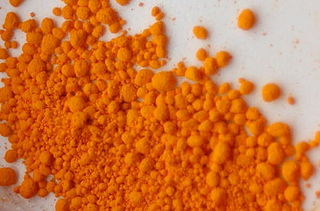Phosphorus trisulfide may refer to:
Phosphorus trisulfide may refer to:

Phosphorus is a chemical element with the symbol P and atomic number 15. Elemental phosphorus exists in two major forms, white phosphorus and red phosphorus, but because it is highly reactive, phosphorus is never found as a free element on Earth. It has a concentration in the Earth's crust of about one gram per kilogram. In minerals, phosphorus generally occurs as phosphate.

A match is a tool for starting a fire. Typically, matches are made of small wooden sticks or stiff paper. One end is coated with a material that can be ignited by friction generated by striking the match against a suitable surface. Wooden matches are packaged in matchboxes, and paper matches are partially cut into rows and stapled into matchbooks. The coated end of a match, known as the match "head", consists of a bead of active ingredients and binder, often colored for easier inspection. There are two main types of matches: safety matches, which can be struck only against a specially prepared surface, and strike-anywhere matches, for which any suitably frictional surface can be used.
Phosphorous can refer to:
WP or wp may refer to:

Arsenic trisulfide is the inorganic compound with the formula As2S3. It is a dark yellow solid that is insoluble in water. It also occurs as the mineral orpiment, which has been used as a pigment called King's yellow. It is produced in the analysis of arsenic compounds. It is a group V/VI, intrinsic p-type semiconductor and exhibits photo-induced phase-change properties.

Mercury(II) oxide, also called mercuric oxide or simply mercury oxide, is the inorganic compound with the formula HgO. It has a red or orange color. Mercury(II) oxide is a solid at room temperature and pressure. The mineral form montroydite is very rarely found.

White phosphorus munitions are weapons that use one of the common allotropes of the chemical element phosphorus. White phosphorus is used in smoke, illumination, and incendiary munitions, and is commonly the burning element of tracer ammunition. Other common names for white phosphorus munitions include WP and the slang terms Willie Pete and Willie Peter, which are derived from William Peter, the World War II phonetic alphabet rendering of the letters WP. White phosphorus is pyrophoric ; burns fiercely; and can ignite cloth, fuel, ammunition, and other combustibles.
Phosphorus oxoacid is a generic name for any acid whose molecule consists of atoms of phosphorus, oxygen, and hydrogen. There is a potentially infinite number of such compounds. Some of them are unstable and have not been isolated, but the derived anions and organic groups are present in stable salts and esters. The most important ones—in biology, geology, industry, and chemical research—are the phosphoric acids, whose esters and salts are the phosphates.
DMTS may be:

Phosphorus sulfides comprise a family of inorganic compounds containing only phosphorus and sulfur. These compounds have the formula P4Sn with n ≤ 10. Two are of commercial significance, phosphorus pentasulfide, which is made on a kiloton scale for the production of other organosulfur compounds, and phosphorus sesquisulfide, used in the production of "strike anywhere matches".
Antimony sulfide may refer to either of two compounds of antimony and sulfur:
Arsenic sulfide may refer to:
Phosphorus is a chemical element with symbol P and atomic number 15.
Phosphorus oxide can refer to:
Phosphorus bromide may refer to:
Tribromide is the anion with the chemical formula Br3−, or salts containing it:

Dimethyl trisulfide (DMTS) is an organic chemical compound and the simplest organic trisulfide, with the chemical formula CH3SSSCH3. It is a flammable liquid with a foul odor, which is detectable at levels as low as 1 part per trillion.

Diphosphorus trisulfide is a phosphorus sulfide with the formula of P2S3. The substance is highly unstable and difficult to study.
In organic and organometallic chemistry, trisulfide is the functional group R-S-S-S-R.
Tungsten trisulfide is an inorganic compound of tungsten and sulfur with the chemical formula WS3. The compound looks like chocolate-brown powder.